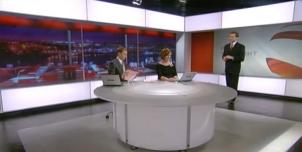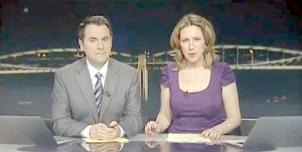Full Freeview on the Huntshaw Cross (Devon, England) transmitter
| Google Streetview | Google map | Bing map | Google Earth | 50.979,-4.100 or 50°58'43"N 4°5'59"W | EX31 3ND |
The symbol shows the location of the Huntshaw Cross (Devon, England) transmitter which serves 37,000 homes. The bright green areas shown where the signal from this transmitter is strong, dark green areas are poorer signals. Those parts shown in yellow may have interference on the same frequency from other masts.
_______
Digital television services are broadcast on a multiplexes (or Mux) where many stations occupy a single broadcast frequency, as shown below.
64QAM 8K 3/4 27.1Mb/s DVB-T MPEG2
H/V: aerial position (horizontal or vertical)
The Huntshaw Cross (Devon, England) mast is a public service broadcasting (PSB) transmitter, it does not provide these commercial (COM) channels: .
If you want to watch these channels, your aerial must point to one of the 80 Full service Freeview transmitters. For more information see the will there ever be more services on the Freeview Light transmitters? page.
Which Freeview channels does the Huntshaw Cross transmitter broadcast?
If you have any kind of Freeview fault, follow this Freeview reset procedure first.Digital television services are broadcast on a multiplexes (or Mux) where many stations occupy a single broadcast frequency, as shown below.
64QAM 8K 3/4 27.1Mb/s DVB-T MPEG2
H/V: aerial position (horizontal or vertical)
The Huntshaw Cross (Devon, England) mast is a public service broadcasting (PSB) transmitter, it does not provide these commercial (COM) channels: .
If you want to watch these channels, your aerial must point to one of the 80 Full service Freeview transmitters. For more information see the will there ever be more services on the Freeview Light transmitters? page.
Which BBC and ITV regional news can I watch from the Huntshaw Cross transmitter?

BBC Spotlight 0.8m homes 2.9%
from Plymouth PL3 5BD, 66km south (184°)
to BBC South West region - 107 masts.

ITV West Country News (West) 0.8m homes 2.9%
from Plymouth PL7 5BQ, 66km south (176°)
to ITV West Country region - 107 masts.
All of lunch, weekend and 50% evening news is shared with West Country (East)
Are there any self-help relays?
| Nth Molton | Transposer | 18 km E Barnstaple | 30 homes |
How will the Huntshaw Cross (Devon, England) transmission frequencies change over time?
| 1968-80s | 1984-97 | 1997-98 | 1998-2009 | 2009-13 | 2013-18 | 2013-17 | 19 Jun 2019 | ||
| VHF | C/D E | C/D E | C/D E | C/D E | C/D E T | C/D E T | W T | ||
| C11 | ITVwaves | ||||||||
| C30 | BBCA | ||||||||
| C31 | D3+4 | ||||||||
| C32 | SDN | ||||||||
| C34 | ArqA | ||||||||
| C35 | ArqB | ||||||||
| C37 | BBCB | ||||||||
| C48 | SDN | SDN | SDN | ||||||
| C50tv_off | BBCA | BBCA | |||||||
| C51tv_off | _local | _local | _local | _local | |||||
| C52tv_off | ArqA | ArqA | ArqA | ||||||
| C55tv_off | BBC1waves | BBC1waves | BBC1waves | -BBCB | -BBCB | -BBCB | |||
| C56tv_off | +ArqB | +ArqB | +ArqB | ||||||
| C59tv_off | ITVwaves | ITVwaves | ITVwaves | -D3+4 | -D3+4 | -D3+4 | |||
| C62 | BBC2waves | BBC2waves | BBC2waves | BBCA | |||||
| C65 | C4waves | C4waves | C4waves | ||||||
| C67 | C5waves | C5waves |
tv_off Being removed from Freeview (for 5G use) after November 2020 / June 2022 - more
Table shows multiplexes names see this article;
green background for transmission frequencies
Notes: + and - denote 166kHz offset; aerial group are shown as A B C/D E K W T
waves denotes analogue; digital switchover was 1 Jul 09 and 29 Jul 09.
How do the old analogue and currrent digital signal levels compare?
| Analogue 1-4 | 100kW | |
| BBCA, D3+4, BBCB | (-7dB) 20kW | |
| SDN, ARQA, ARQB | (-10dB) 10kW | |
| Mux 1*, Mux 2*, Mux A*, Mux B*, Mux C*, Mux D* | (-14dB) 4kW | |
| Analogue 5 | (-17dB) 2kW |
Which companies have run the Channel 3 services in the Huntshaw Cross transmitter area
|
|
Is the transmitter output the same in all directions?
Radiation patterns withheldSaturday, 2 September 2023
C
Chris.SE4:34 AM
Kathryn Johnson :
Did you not read the post before yours!
If you provide a full postcode (or one from a very nearby shop/pub/garage etc) we may be able to offer further advise.
If the listing is accurate, it looks as though some work may continue next week.
| link to this comment |
M
Michael11:00 AM
We have always had occasional interference from France under high atmospheric pressure.
Let's hope the current engineering work results in improved reception for us all:-)
| link to this comment |
Tuesday, 31 October 2023
M
michael10:43 AM
Sort of reassuring - so not my new modified yagi -:) Arq A and B went borderline again...
Is there a technical reason why the 10kW muxes can't be upgraded to 20kW
like the BBC and ITV muxes? Or is it simply down to cost???
| link to this comment |
S
Steve Donaldson3:53 PM
michael: I haven't seen it written down explicitly, such as in an Ofcom document, as to why at many transmitting stations the COMs are half power to the PSBs. I will therefore offer my thoughts on why it might be. One reason may be to counter CCI, as the channels used by COMs are often also used by closer transmitters than for PSBs.
Taking Huntshaw Cross, its COMs are now co-channel with Mendip's PSBs. While these are neighbouring transmitters, it looks like the high ground of Exmoor may help shield Huntshaw Cross from viewers of Mendip. Prior to 700MHz Clearance Huntshaw Cross' COMs were co-channel with Mendip's COMs.
Another area where neighbouring transmitters are co-channel is between Stockland Hill and Rowridge, with the former's COMs at half-power, and the latter's HP COMs at quarter power and VP COMs at full power.
On the opposite side of Stockland Hill's coverage area there is overlap with Caradon Hill, the former's COMs being co-channel with the latter's PSBs.
The impetus was to have the PSB coverage as good as the former analogue, hence PSBs get channels reused by (co-channel with) transmitters at greater distance. Where these are reused by adjacent or nearby COMs, then I think this is one reason the COMs need to talk a bit quieter, to not be so powerful.
Of course, cost may be another reason because of the law of diminishing returns. For each incremental increase in power, there are less and less additional viewers added. Plus, the potential for interference to viewers of other transmitters increases.
| link to this comment |
C
Chris.SE7:25 PM
michael:
Actually I think Steve has summed it up quite accurately. CCI and protection of the PSBs is the primary objective, especially when you bear in mind that there are over 1100 Freeview transmitters in the country of which 80+ are main transmitters.
| link to this comment |
Wednesday, 1 November 2023
M
michael11:13 AM
Steve and Chris: That all makes sense! I actually thought interference might get worse with all muxes now rivals for "power" in the lower end of the new DTT spectrum. Ofcom arguably did a good re-allocation job! During the "tinklering interval" HX was better. My diy-yagi helped, but Carmel still sneaks through reflector gaps :-) I will work on an "upgrade" with a less penetrable mesh reflector, to be mounted in the Spring. If our Panasonic smarty allowed auto-retuning to be de-selected, I would be happy. But, hey ho, we are where we are!
Unrelated : Why-oh-why does Auntie insist on extended live coverage on the News Channel when it has
at least one spare channel, often used for sport or music broadcasts, for special event coverage???
Sometimes ch 231 is even duplicated on BBC1 or 2.
| link to this comment |
S
Steve Donaldson4:45 PM
michael: I remember reading on mb21 a while about your self-help relay which was scuppered by Carmel. I know you are now trying to achieve a solution to pick up the full complement of channels from Huntshaw Cross. That Carmel is also a problem with this -- not due to CCI but lack of forethought by the manufacturer to offer a setting to deactivate the periodic automatic tuning.
You said yesterday that COM5/Arq A and COM6/Arq B went borderline again. I read into this that COM4 did not. A possible interferer on COM5 / C34 and COM6 / C35 but not the other four channels is Kippure. A more substantial reflector may help with the Carmel problem but it may also help guard against interference from Kippure, if it is it which is the cause of variable COM5 and COM6 reception.
Kippure is 165 miles out on a bearing of 327deg from Lee, give or take a degree or two. It broadcasts on C34 and C35 with horizontal polarity. There is a notch on both channels for Huntshaw Cross: -8dB 138-145deg; -7dB 148-155deg.
Huntshaw Cross is on a bearing of 170deg. Carmel is at 8 deg and Kippure is, as I have said, at 327deg.
ComReg has published the MoU between Ireland and the UK for DTT post-700MHz Clearance:
https://www.comreg.ie/pub…mreg
This is where I have taken the information about the Kippure notches from. Transmitters in Ireland have six channels allocated in the MoU, although at present the network consists of just two.
The full list of TV transmitters in Ireland is here:
https://2rn.ie/wp-content….pdf
| link to this comment |
S
Steve Donaldson4:49 PM
michael: I omitted to say that Kippure is 125kW.
| link to this comment |
Thursday, 2 November 2023
M
michael10:34 AM
Steve, thanks for the Kippure info. Didn't know about that! Yes, I was on mb21, a very helpful source when I was trying to save our self-help relay.
My "patent" yagi survived the night's weather. I will look further into the Kippure radiation pattern and hope to exclude it in the Spring.
Thanks again for the valuable pointer!
Michael
| link to this comment |
Select more comments
Your comment please!




